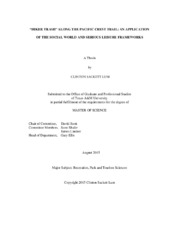| dc.description.abstract | This study took place along the Pacific Crest Trail (PCT), a 2,665-mile footpath in the Western United States. The PCT has seen increased use; the Pacific Crest Trail Association (PCTA) recorded 369 hikers completing the trail during the 2014 hiking season. The increased use of the resources along the PCT corridor has implications for participants, citizens of gateway communities and natural resource managers alike and has been all but ignored from leisure scientists. This study sought to better understand the growing social world of hikers along the PCT by answering two interrelated questions. First, are there subworlds of hikers along the PCT and if so, what are the sources of differentiation? And second, what effect does a hiker’s social world have on his or her experience? To answer these questions, both qualitative and quantitative methods were employed.
Throughout 45 days spent in the field collecting data, fifteen in depth interviews were conducted, extensive participant observation was undertaken, and narrative analysis was performed. In addition to these qualitative means, 153 experience use history (EUH) surveys were administered to gauge the experience levels of hikers along the PCT. This study found that the relationships formed between fellow members of the PCT long-distance hiking community had a positive effect on the hiking experience. This study was also consistent with the assertion that social worlds tend to dissolve into subworlds. The subworlds along the PCT formed around one’s ideas about authentic hiking. Two subworlds were identified within the long-distance hiking social world: the purist and the social hiker. Both, purists and social hikers have an idyllic approach to hiking the PCT and consider those who deviate from this standard as “doing it wrong.” One theme that emerged during this study in addition to hikers’ contesting authenticity is participants’ concern over the increasing amount of hikers utilizing the trail. This study adds to the social world body of literature and also illuminates the need for this particular social group and environment to be examined using several different frameworks including recreation specialization and serious leisure, carrying capacity, place attachment and social bonding. The PCT has not been researched in great detail and the growing number of participants along the trail will soon demand academic inquiry to provide information for managers of natural resources. | en |


